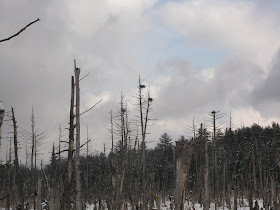Here are some of the elements of a perfect woodland adventure: beautiful weather, delightful companions, and a destination worth busting your butt to get to. All these and more were ours yesterday as our group of seven followed expert tracker Vince Walsh on a trek through snow-covered marsh and forest to commune with 800-year-old Black Tupelo trees (Nyssa sylvatica). Here's a photo of us before we set out (that's Vince with the red backpack straps). Doesn't everybody look happy? And why shouldn't we be? Just look at all that beautiful snow! The prettiest snowfall all winter.

And here we are setting off across the marsh that is part of Vince's property. Vince runs a nature education center here in Greenfield called Kawing Crow, and his 60 forested acres adjoin the 900-acre Lincoln Mountain State Forest where those ancient Black Tupelos grow. Quite a ways and several hours away, it turned out, and through trackless, heavy deep snow. Some of us older folks were mighty glad to have somebody younger and stronger leading the way and (pant! pant!) breaking trail.
We didn't exactly make a beeline toward those trees, since several exciting distractions called us a bit off course. For one thing, we found the trail of a very energetic River Otter tobogganing through the woods and in and out of streams. And of course we wanted to follow that trail to see what the otter had been up to. We even found some otter scat, which most of our group agreed smelled pretty fishy.

We passed through another marsh when we reached the state forest, and stood for a while to gaze at all the Great Blue Heron nests on the snags out there. Last year when I came to this marsh with Vince, we saw two Great Horned Owls perched on one of those nests. No sign of them this year.
But here's the photo I took of them last year, on March 23. Maybe they'll be back by that date this year.
Finally, we reached the heart of the swamp where the ancient tupelos grow, the second oldest stand of trees of any kind in New York State. The odd thing is, these trees are not enormous. Neither in height nor in girth. Vince explained to us that tupelos die from the top and actually grow shorter as they age. As the photo shows, the neighboring much-younger spruce is almost the tupelo's equal in height. But oh my, these trees have a presence! Just imagine all the human history that has passed since these trees first sprouted, like around 1200 AD!
We all wondered why these trees had never been cut, since the forest surrounding them has been lumbered several times over. Vince told us that tupelo wood is almost impossible to cut, with interlacing fibers that run crosswise to each other. Any tupelo boards would warp easily, making the lumber useless for building. Also, these trees tend to hollow out from the bottom once they reach a certain age, and these trees already would have been around 300 years old before any Europeans could have found them. He showed us several hollow trunks, including the one in this photo, where a porcupine had denned many years, leaving a long-composted pile of scat at the base of the tree (now covered with the snow Vince is scraping away).
Here's another view of an ancient tupelo, looking up at the crown. Those convoluted branches appear quite different from the graceful sloping branches of younger tupelo trees, but the very twiggy appearance is typical of the species at any age.
For comparison, here's a photo of younger tupelos that grow along the Hudson River at Moreau.
 I had never seen a tupelo tree until I saw these about 15 years ago while paddling above the Sherman Island Dam. I first came upon them in autumn when their leaves were the most spectacular cranberry red.
I had never seen a tupelo tree until I saw these about 15 years ago while paddling above the Sherman Island Dam. I first came upon them in autumn when their leaves were the most spectacular cranberry red. 
Smitten, I just had to know their name. My research revealed that tupelos are usually a more coastal species, but because of a microclimate that extends up the Hudson/Champlain Valley, they grow quite happily here, although not as commonly as birches or maples. And as those trees we saw Sunday prove, they've been growing here a long, long time.
To see more photos and lively accounts of our tupelo trek, check out Ellen Rathbone's blog, Adirondack Naturalist , and that of my other blog-buddy, Sue, called Water Lily .






That's awesome -- being able to get out and explore with friends and teachers, in am area that otherwise requires other means of access in warmer seasons. I'm jealous, but share your joy!
ReplyDeleteYes, you said it well in reflecting on such ancient trees -- I find a palpable sense of reverence in their presence -- it's sacred space!
Thanks for sharing!
Nice overview of our trip, Jackie! I still have to put up my photos - perhaps today.
ReplyDeleteA Good time was had by All - !
ReplyDeleteYou captured the feeling that day.
Yup and there are more photos coming on my blog too, maybe not for a day or two -- this walk brought to you in Blogarama! Sort of like those dressing-room mirrors, showing 3 angles of the same thing.
Jackie & Ellen - looking forward to our next trek !
oh and it was good to see Laurie too -- it was fun looking at all the "nice" boulders !
ReplyDelete